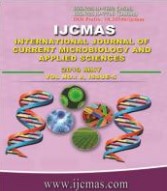


 National Academy of Agricultural Sciences (NAAS)
National Academy of Agricultural Sciences (NAAS)

|
PRINT ISSN : 2319-7692
Online ISSN : 2319-7706 Issues : 12 per year Publisher : Excellent Publishers Email : editorijcmas@gmail.com / submit@ijcmas.com Editor-in-chief: Dr.M.Prakash Index Copernicus ICV 2018: 95.39 NAAS RATING 2020: 5.38 |
The present study was conducted to know the diversity of tick species infesting domestic and crossbred cattle in 4 districts of Assam along the Indo-Bhutan border for one year. A total of 533 cattle were examined, 266 (49.90%) were found infested either with Rhipicephalus (Boophilus) microplus (23.45%) or Haemaphysalis bispinosa (15.75%) or with both the ticks (10.69%). Crossbred cattle were found having higher tick prevalence (53.50%) compared to the indigenous (49.34%) which was statistically non-significant. Infestation was highest in adult cattle > 3 years of age (56.61%) and the lowest in calves < 1 year of age (41.74%). Higher prevalence was recorded in female (53.57%) than the males (44.80%) and also higher in free ranged indigenous cattle (49.34%) than that of crossbred stall fed cattle (41.55%). According to the distribution of ticks on different body parts of cattle, infestation was observed highest in inguinal region including udder and external genitalia (82.70%) followed by neck (71.42%) and lowest seen in back region (22.55%). Cattle and other animals are being regularly traded across the porous Indo-Bhutan border areas. Such activities can pose as the risk factors for transmission of various tick borne diseases. The level of infestation, seasonal epidemiology of ticks and associated management practices to adopt are discussed.
 |
 |
 |
 |
 |